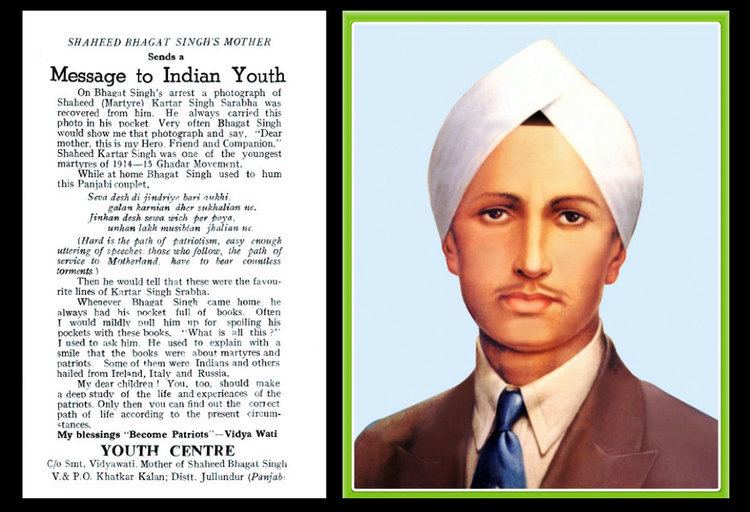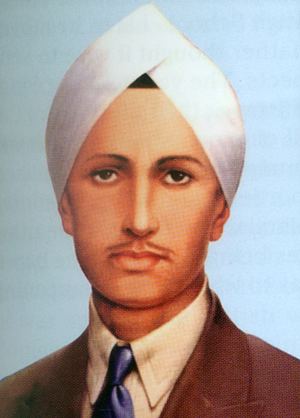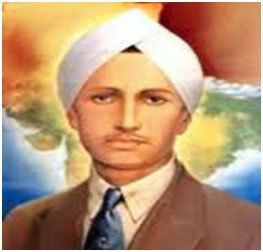Name Kartar Sarabha | ||
 | ||
Movement Indian Independence movement, Similar People | ||
Speech of Bhai Ajmer Singh at Sarabha village on Shaheed Kartar Singh Sarabha
Kartar Singh Sarabha (Punjabi: ਕਰਤਾਰ ਸਿੰਘ ਸਰਾਭਾ ; کرتار سنگھ سرابھا ; 24 May 1896 – 16 November 1915) was an Indian Sikh revolutionary who is among the most famous and reputed martyrs of Punjab. He was only 17 years old when he became a member of Ghadar Party, then came up as a leading luminary member and started fight for an independent India. He was one the most active persons in the movement. Singh was executed at Lahore in November 1915 for his role in the movement in February 1915 when he was only 19 years old.
Contents
- Speech of Bhai Ajmer Singh at Sarabha village on Shaheed Kartar Singh Sarabha
- Real hero shaheed kartar singh sarabha gadar party forgotten hero of india indian revolutionary
- Early life
- Ghadar Party and newspaper
- Revolt in the Punjab
- Betrayal
- Verdict and execution
- Legacy
- References

Real hero shaheed kartar singh sarabha gadar party forgotten hero of india indian revolutionary
Early life

Kartar Singh Sarabha Grewal was born on 24 May 1896 in Ludhiana, Punjab India into a Sikh family in village Sarabha, district Ludhiana, Punjab. His father was Sardar Mangal Singh Grewal and his mother was Sahib Kaur. When he was very young, his father died and his grandfather Badan Singh Grewal brought him up. After receiving his initial education in his village, Kartar Singh entered the Malwa Khalsa high school in Ludhiana; he studied until 8th standard. Then he went to his uncle (father's brother) in Orissa and stayed there for over a year, During this time he took lessons for standard 10 from a high school in Ravenshaw University, Cuttack, Orissa.

After coming back to his grandfather, his family decided to board him to the United States for higher studies. He sailed to San Francisco in July 1912. He was supposed to get enrolled in University of California, Berkeley but for some unknown reasons he did not take admission in any college. In a historical note by Baba Jwala Singh, what mentioned is that when i went to Astoria, Oregon in December 1912 i found Kartar Singh working in a mill factory. Most of the people will say that he studied in the respective college but the college itself did not get any record of enrollment with his name.
A great man named Sohan Singh Bhakna founder of Ghadar Party almost double the age of Kartar Singh inspired him for independence of British Ruling India, from then he put all of his power in making this happen.Sohan Singh Bhakna called Kartar Singh as "Baba Gernal". He started learning how to shoot with a gun or pistol from local Americans, and he also learned how to make a bomb. One of the famous things about his learning is that he took lessons in flying an airplane.

In 1914, Indians worked in foreign countries either as indentured labourers or soldiers fighting for the consolidation of British rule or extending the boundaries of the British Empire. He frequently spoke with other Indians about freeing India from British rule.
Ghadar Party and newspaper

On 21 April 1913, the Sikhs of California assembled and formed the Ghadar Party (Revolution Party). The aim of the Ghadar Party was to get rid of the slavery of the British by means of an armed struggle. On 1 November 1913, the Ghadar Party started printing a paper named Ghadar, which was published in Punjabi, Hindi, Urdu, Bengali, Gujarati and Pushto languages. Kartar Singh did all the work for that paper.

This paper was sent to Indians living in all countries throughout the world. The purpose of the paper was to unmask the truth about British rule to Indians, impart military training, and explain in details the methods of making and using weapons and explosives.

Within a short time, the Ghadar Party became very famous through its organ: The Ghadar. It drew Indians from all walks of life.
Revolt in the Punjab
With the start of World War I in 1914, the British became thoroughly engrossed in the war effort. Thinking it to be a good opportunity, the leaders of the Ghadar Party published the "Decision of Declaration of War" against the British in issue of 'The Ghadar' dated 5 August 1914. Thousands of copies of the paper were distributed among army cantonments, villages and cities. Kartar Singh reached Calcutta via Colombo on board SS Salamin in November 1914: he accompanied two other Gadhar leaders, Satyen Sen and Vishnu Ganesh Pingle, along with a large number of Gadhar freedom fighters. With a letter of introduction from Jatin Mukherjee, the Jugantar leader, Kartar Singh and Pingle met Rash Behari Bose at Benares to inform him that twenty thousand more Gadhar members were expected very soon. A large number of leaders of the Ghadar Party were arrested by the Government at the ports. In spite of these arrests, a meeting was held by members of the Ghadar Party at Ladhouwal near Ludhiana in which it was decided to commit robberies in the houses of the rich to meet requirements of finance for armed action. Two Ghadris, Waryam Singh and Bhai Ram Rakha were killed in a bomb blast in one such raid.
After the arrival of Rash Behari Bose at Amritsar on 25 January 1915, it was decided on a meeting on 12 February that the uprising should be started on 21 February. It was planned that after capturing the cantonments of Mian Mir and Ferozepur, mutiny was to be engineered near Ambala and Delhi.
Betrayal
Kirpal Singh, a police informer in the ranks of the Ghadar Party, had a large number of members arrested on 19 February and informed the government of the planned revolt. The government disarmed the native soldiers due to which the revolt failed.
After the failure of the revolution, the members who had escaped arrest decided to leave India. Kartar Singh, Harnam Singh Tundilat, Jagat Singh etc. were asked to go to Afghanistan and they did make a move towards that area. But Kartar's conscience did not permit him to run away when all his comrades had been held. On 2 March 1915, He came back with two friends and went over to Chak No. 5 in Sargodha where there was a military stud and started propagating rebellion amongst the armymen. Risaldar Ganda Singh had Kartar Singh, Harnam Singh Tundilat, and Jagit Singh arrested from Chak No. 5, district Lyallpur.
Verdict and execution
He soon became the symbol of martyrdom and many were influenced from his bravery and sacrifice. Bhagat Singh, another great revolutionary of Indian freedom, regarded Kartar Singh as his guru, friend and brother. A statue of him was erected in Ludhiana, and Punjabi novelist Nanak Singh wrote a novel called Ikk Mian Do Talwaran based on his life. The judges during his trial were impressed by his intellectual skills, but nevertheless he was sentenced to death by hanging. He wrote a popular song which he would sing and it is said that he died singing it:
"ਸੇਵਾ ਦੇਸ਼ ਦੀ ਜਿੰਦੜੀਅੇ ਬੜੀ ਔਖੀ,Sewa desh di jindariye badi aukhi
ਗੱਲਾਂ ਕਰਨੀਆਂ ਢੇਰ ਸੁਖੱਲੀਆਂ ਨੇ,Gallan karniya dher sokhaliyan ne
ਜਿੰਨੇ ਦੇਸ਼ ਦੀ ਸੇਵਾ ਚ ਪੈਰ ਪਾਇਆjihne desh di sewa 'ch per paeya
ਓਹਨਾ ਲੱਖ ਮੁਸੀਬਤਾਂ ਝੱਲੀਆਂ ਨੇ."Ohna lakh musibtaan jhalliyan ne
Serving ones country is very difficultIt is so easy to talkAnyone who walked on that pathMust endure millions of calamities.The judgement in respect of 63 arrested Gadharites was pronounced on 13 September 1915, at the Central Jail, Lahore. In this first conspiracy case of 1914–15, 24 Gadarites were sentenced to death. Kartar Singh was one of them.
The court observed that Kartar Singh was the most dangerous of all the rebels. "He is very proud of the crimes committed by him. He does not deserve mercy and should be sentenced to death". Kartar Singh was hanged in the Central Jail of Lahore on 16 November 1915, aged 19.
Legacy
Bhagat Singh was inspired by him.
